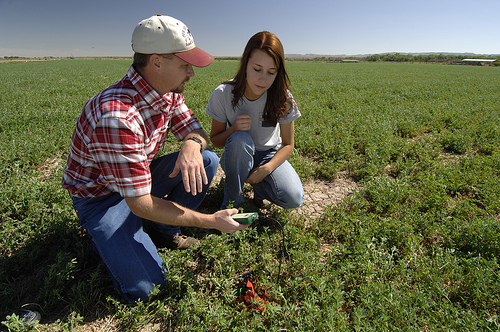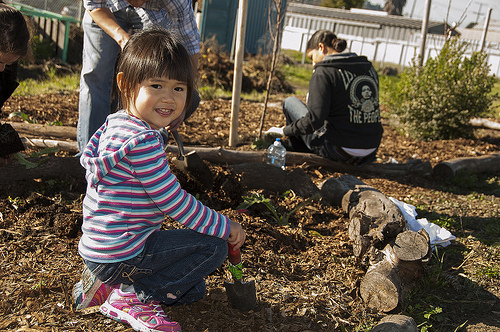Demand for local and regional foods is strong and growing, as consumers across the country are looking for healthy food options grown and raised in their own communities. USDA has long supported this effort along with the procurement of regional foods by schools and helping them increase food literacy among the nation’s children.
These efforts will be the topic of the “Showcasing Local Foods” session at USDA’s 2013 Agriculture Outlook Forum, February 21-22, where Dr. Sonny Ramaswamy, director of USDA’s National Institute of Food and Agriculture (NIFA), will moderate a panel of speakers to discuss how local foods can lead to more nutritious diets. Lela Reichart with the Pennsylvania Department of Agriculture will discuss the Specialty Crop Block Grant Program, which focuses on nutrition knowledge and related topics. USDA Food and Nutrition Service’s Deborah Kane will discuss the Farm to School Program that isbringing more locally sourced fresh fruits and vegetables into school cafeterias. Tom Coon, from Michigan State University, will discuss Cooperative Extension’s role in educational programs related to regional and local food systems. Read more »

“Beginning farmers are a key to twenty-first-century agriculture," says Agriculture Secretary Tom Vilsack.
Clay Blackburn is a 25-year-old Missouri farmer who works several part-time jobs to keep his cow/calf operation growing. He currently leases 200 acres of land until he can build enough capital to buy.
“It’s tough for a young person to get started in farming,” said Blackburn. “Finding land is the most difficult thing, but I’m determined to eventually make this my full-time job.” Read more »
During a brief but busy trip to Oregon Monday, January 28, Agriculture Under Secretary Dallas Tonsager highlighted opportunities to increase public-private collaboration and innovative financing models for rural community and economic development. That morning, Mr. Tonsager delivered the keynote address at the Harvesting Clean Energy conference in Corvallis. Later that day in Portland, Mr. Tonsager sat down with a diverse group of business, technology, education, agriculture, finance and state government representatives to stress the importance of inter-entity teamwork to achieve a common vision for a self-sustaining, prosperous rural America.
“Our mission is to help create jobs in rural America,” Mr. Tonsager explained. “We are looking for creativity, especially as it relates to putting capital together for rural areas so that we can extend our resources further in a thoughtful, sensible way.” Read more »
USDA programs have targeted assistance to beginning farmers and ranchers since the 1992 Agricultural Credit Improvement Act. Farms or ranches are considered “beginning” if the operators have managed them for 10 years or less. The Economic Research Service has looked at the trend in numbers of beginning farmers and ranchers in recent decades and examined some key characteristics that distinguish them from established farms using the Census of Agriculture and the Agricultural Resource Management Survey. Taken every five years, the Census provides the only source of uniform, comprehensive and impartial agricultural data for every county in the nation.
For more than two decades, the share of farms operated by beginning farmers has been in decline. Beginning farms and ranches accounted for 22 percent of the nation’s 2 million family farms and ranches in 2011 – down from about 38 percent in 1982. Consistent with this trend, the average age of principal farm operators in the United States has risen in that period, from 50 to 58. Read more »
There are more than 160,000 public water systems providing water to almost all Americans at some time in their lives. Millions of Americans receive high quality drinking water every day from their public water systems. But access to quality drinking water cannot be taken for granted.
Like many small towns in rural America, the Town of Otter Creek in Levy County, Florida, strives to provide its residents with safe, high quality water. Unfortunately, for this community of under 150 people, poor quality drinking water is a reality. With high levels of trihalomethanes and iron in the water supply, town officials faced a potential health hazard and a lack of financial resources to address the problem. The Town was issued a Consent Order by the Florida Department of Environmental Protection to find a solution for the water quality issue. Given the town’s median household income of $18,000, and limited town resources, town officials sought assistance to develop a plan toward remedying the situation. Read more »

Maya Kwok, 3, helps during a planting project at the Richmond, Edible Forest as part of the Martin Luther King Jr. Day of Service. Maya is the daughter of Alfred Kwok, assistant station director, business operations, for the U.S. Forest Service’s Pacific Southwest Research Station. (U.S. Forest Service photo)
From planting fruit trees in a Richmond, Calif., edible forest to laying 32 feet of boardwalk to make an Atlanta urban forest accessible to everyone, U.S. Forest Service employees across the country joined their communities to make a difference as part of the Martin Luther King Jr. National Day of Service. Read more »


